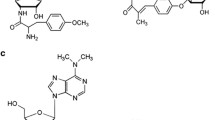Abstract
Penicillins, cephalosporins and cephamycins are peptide antibiotics synthesized by condensation of l-α-aminoadipic acid, l-cysteine and l-valine to form the tripeptide δ(l-α-aminoadipyl)-l-cysteinyl-d-valine (Aad-Cys-Val) by a non-ribosomal peptide synthetase. The genes pcbAB and pcbC, common to all penicillin and cephalosporin producers, that encode the Aad-Cys-Val synthetase1 and isopenicillin N (IPN) synthase1 respectively, have been cloned and the encoded enzymes studied in detail. The IPN synthase has been crystallized and its active center identified, providing evidence for the molecular mechanism of cyclization of the tripeptide Aad-Cys-Val to isopenicillin N. The late genes of the penicillin and cephalosporin pathways have also been characterized although some of the molecular mechanisms catalyzed by the encoded enzymes (e.g. IPN acyltransferase) are still obscure. In cephamycin-producing organisms, biosynthesis of the α-aminoadipic acid precursor proceeds in two steps catalyzed by lysine 6-aminotransferase and piperideine-6-carboxylic acid dehydrogenase. The gene lat for the first of these enzymes is located in the cephamycin gene cluster, providing an interesting example of association of genes encoding enzymes for the formation of a precursor with genes involved in assembly of the antibiotics. Novel enzymes involved in methoxylation at C-7 and carbamoylation at C-3′ of the cephem nucleus were isolated from Nocardia lactamdurans and Streptomyces clavuligerus. The methoxylation system is encoded by two linked genes cmcI-cmcJ and their products (proteins P7 and P8) form a complex that is required for hydroxylation at C-7 and for the subsequent methylation of the 7-hydroxycephem derivative to form the methoxyl group. Carbamoylation at the C-3′-hydroxyl group of the cephem nucleus is catalyzed by a specific carbamoyltransferase encoded by the gene cmcH. Finally, genes for a β-lactamase (bla), a penicillin-binding protein (pbp) and a transmembrane protein (cmcT) that appears to be involved in cephamycin exportation, are clustered together with the biosynthetic genes in the cephamycin clusters of S. clavuligerus and N. lactamdurans. Availability of the cloned genes allows metabolic engineering of the β-lactam biosynthetic pathways such as a channelling precursors and directed removal of bottlenecks in the β-lactam biosynthetic pathways. Several new β-lactam antibiotics have been discovered in gram-positive and gram-negative bacteria that will provide new genes for combinatorial synthesis of new molecules.
Similar content being viewed by others
Author information
Authors and Affiliations
Additional information
Received: 2 December 1997 / Received revision: 20 February 1998 / Accepted: 24 February 1998
Rights and permissions
About this article
Cite this article
Martín, J. New aspects of genes and enzymes for β-lactam antibiotic biosynthesis. Appl Microbiol Biotechnol 50, 1–15 (1998). https://doi.org/10.1007/s002530051249
Issue Date:
DOI: https://doi.org/10.1007/s002530051249




